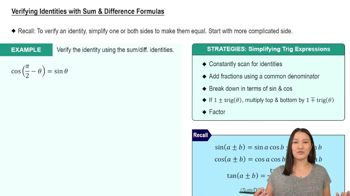Textbook Question
Verify that each equation is an identity.
sin² α + tan² α + cos² α = sec² α
335
views
 Verified step by step guidance
Verified step by step guidance



Verify that each equation is an identity.
sin² α + tan² α + cos² α = sec² α
Verify that each equation is an identity.
(sin 2x)/(sin x) = 2/sec x
Use the given information to find sin(s + t). See Example 3.
sin s = 3/5 and sin t = -12/13, s in quadrant I and t in quadrant III
Use the given information to find the quadrant of s + t. See Example 3.
sin s = 3/5 and sin t = -12/13, s in quadrant I and t in quadrant III
Write each expression in terms of sine and cosine, and then simplify the expression so that no quotients appear and all functions are of θ only. See Example 3.
tan θ cos θ
Find cos(s + t) and cos(s - t).
sin s = 2/3 and sin t = -1/3, s in quadrant II and t in quadrant IV